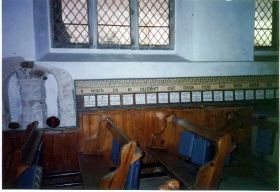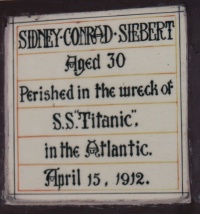



The Parish Church of St George the Martyr, Waterlooville

Memorial 8. All Saints, Brightlingsea, Essex.
Brightlingsea on the Essex coast has a long maritime history as a fishing port. The Norman church high on a hill overlooking the town contains a unique series of naval memorials -
The tradition goes back to 1883 when the vicar, Rev John Pertwee, was greatly shocked when news was received that 19 Brightlingsea fishermen had drowned on the Terschelling oyster grounds off the Dutch coast leaving 32 orphaned children. So he decided to commemorate all maritime deaths of Brightlingsea men from the time of his appointment to the parish in 1872.
Each tile is dated with the name of the man, his ship and the circumstances of his death, thus forming a wonderful historical record. The oldest tile dated 9 Dec 1872 commemorates David Day and his son lost on the schooner William off Hartlepool, whilst the most recent -
Other examples include Sidney Silbert lost on the Titanic and William Webb drowned when the emigrant ship Kapunda collided off Maceco Brazil. Then there were Fred Simons (67) and Fred Wheeler (54) who died on 29 Nov 1924 whilst on the training ship Marlborough in the English Channel. Second World War deaths include 62 years old Walter P Hick on the yacht Campeador, June 22 1940, which had been involved in the Dunkirk evacuations. Also Lt Ron Frost on the submarine P33 sunk off Tobruk in August 1941 and George Scott, a merchant seaman torpedoed on the tanker Sourabaya in the North Atlantic on 26 October 1942. The list is endless but what a wonderful tribute to the fishermen and seamen of Brightlingsea lost at sea in the last 150 years.
John Symonds
Summer Edition 2012
The Naval Memorials

